|
In 1935 a new German warship was launched from the Germaniawerft shipyard at Kiel. The new ship was a destrpyer/escort boat of 756 tons. It was 249.1 feet (75.9 metres) long, 28.9 feet (8.8 metres) and with a draught of 10.6 feet (3.2 metres). The ship was given the name F2.
The F2 was powered by two geared Brown-Boveri steam turbines (total 14,000 shp) which got their steam from oil-fired boilers. She was capable of 26 knots. She was the second unit built of a class of 10. She had a radius of action of 1500 miles at 20 knots. Her armament consisted of 2 x 105 mm deck mounted guns, 4 x 37 mm AA guns (removed in 1938/9) and 4 x 20 mm AA. She was crewed by 121.
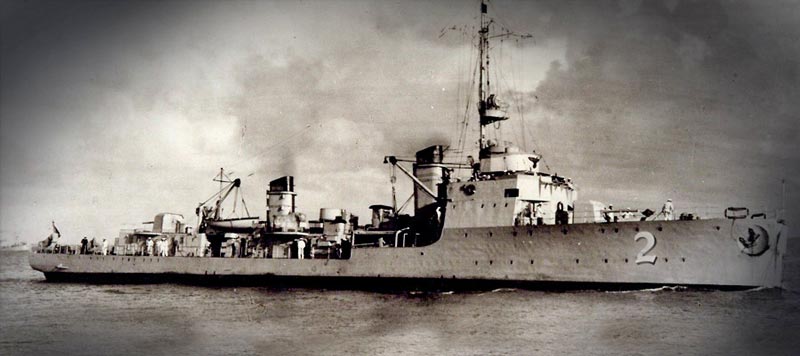 |
| The F2 |
The design was said to be experimental as the ship was built with high-pressure boilers. Reports state that the F2 was not a good boat at sea. Probably because of this, the boat was lengthened by four metres and converted to a torpedo recovery vessel at Wilhelmshaven in 1938/9. She was now 263.1 feet (80.1 metres) long. Her maximum speed was reduced to 26 knots.
Little is known about her war service. After the war the ship was handed as reparations to Britain. On 30 December 1946 she was moored at Scapa Flow in the Orkney Islands, Scotland. She was located in Gutter Sound, just off Mill Bay and to the north of the small village of Lyness. Gutter Sound is the water between Hoy, Fara and Rysa Little Islands.
 |  |
| The F2 | The F2 |
It seems that the F2 had a leak and on that day she sank at her moorings during a storm. She lay there till 1967 or 1968 when she was sold for scrap to Metrec Engineering. The company decided to salvage parts of the F2 and used a wooden barge, YC21. However, after some salvage work had been done, the barge sank during a storm on 15 November 1968. The YC21 was full of salvaged items from the F2. Since then, no further salvage work has been carried out on either vessel.
Today the wrecks are located at a GPS mark of N58° 50.7' W3° 11.5'. There are buoys located on both the F2 and the YC21. The depth here is about 16 metres and the bottom is a mixture of sand and shale.
I am not sure if the GPS mark above is on the barge or the F2, but there are
buoys on both. We descended on the barge. The shotline is tied off to an arm at the bow. This is at 11 metres. The main deck of the barge is about 14 metres. In the hold you will see a number of things salvaged from the F2. There are two AA guns, one pointing up and the other pointing down. Dropping into the hold you can see them clearly.
On the starboard side under the deck there are what appears to be two compressors. Once you move to the rear of the hold you can exit out through some compartments which appear to have been crew accommodation. You can exit out the stern by ascending back to the main deck and exiting here. There are more cabins here as well.
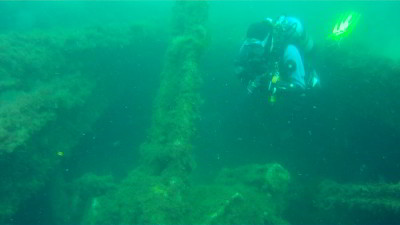 | 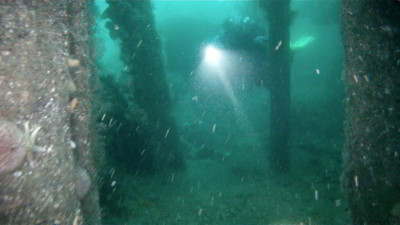 |
| Michael and the upright AA gun in the barge hold | The inside of the barge looking to the stern |
There is a rope attached to the stern port side of the barge. This runs across the bottom to the F2 at a depth of about 16 metres. It is only about 40 metres or so. The rope is tied to the rear of the intact bow section. The F2 is on her port side, with the bow facing the south. We had a slight current so we drifted along the hull bottom to the bow. The wreck stands quite high in spots, up to about 11 metres.
As you round the bow you will see that there is an air bubble in the anchor hawser. Once you are on the deck side, you will see two anchor capstans. There is also a bow gun which is very nice.
You can enter the wreck here and see the capstan mechanisms. Swim along this lower deck towards the stern (it is very easy and safe) and exit out the rear. As you go you can look into some hatches that give access to the next deck down.
 | 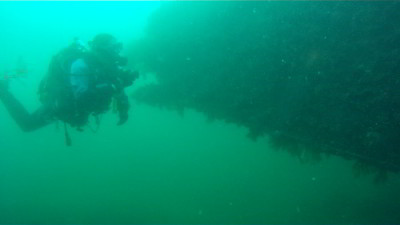 |
| Michael looking to an air bubble in the anchor howser of the F2 | Michael rounds the bow of the F2 |
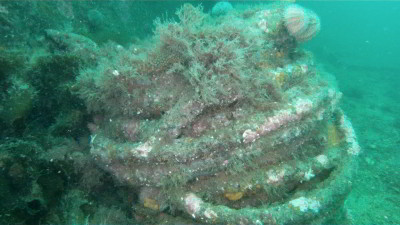 |  |
| Rope or pipe in the bow of the F2 | The capstan winch mechanism in the bow of F2 |
Once you exit the wreck, you will come across the remains of the bridge. This is laying out on the sand and is totally wrecked. There is a mast on the sand and behind this and out a bit what appears to be a gearbox.
The wreck from here to the stern is extremely broken up. There is a lot of copper piping all over the place as well as bits of metal from the hull and deck spread everywhere. At the stern, which is not in straight line with the bow section, you can see the steering mechanism as well as the rudder. This stern section appears to be upright, but it is hard to tell.
 |  |
| Michael looking to an air bubble in the anchor howser of the F2 | Michael rounds the bow of the F2 |
 |  |
| Rope or pipe in the bow of the F2 | The capstan winch mechanism in the bow of F2 |
Coming back down the starboard side of the wreck and out a bit you will see another gearbox. This is about 10 or 15 metres to the north of the rope that connects the two wrecks. Come back to the wreck and examine this area in more detail (you should have been down about 30 or so minutes) as you should have time and air.
If you look carefully you can see part of a boiler (I am not sure if there are two, but I assume there are). There is another rope here that runs off in a south-easterly direction for about 100 metres. I did not follow this but it apparently leads to the wreck of a dive boat and I think perhaps some items that were salvaged from the F2.
Either follow the rope or spend the rest of your time having another look at the bow section. We ended up ascending the shotline attached to the rear of the bow section (I think near where the rope from the barge is attached).
We did a bottom time of just over 40 minutes and never came within 32 minutes of decompression. We were using air and this was the second dive of the day. Water temperature was 11° and visibility was about seven metres.
 |
| A download from my computer showing our profile for the dive from the barge to the F2 |
To be honest, while this was a nice and interesting dive, I would have preferred to dive one of the shallower German World War I wrecks but was out voted by the rest of the divers.
All underwater photos taken from video using a GoPro camera.
Kelly and I dived with MV Radiant Queen. The owners built a new boat since then which is called MV Huskyan. I would recommend them as we thought the operation was the best overall day charter boat we have used anywhere in the world and the new boat is heaps better than the old one.
Click here to see the list of wrecks
References:
| 
 v6.00.307 © 2003-2005
v6.00.307 © 2003-2005